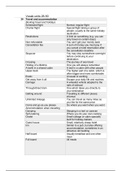Samenvatting SM
Chapter 1
Key characteristics strategy:
Strategy is essentially about the future but primarily about the uncertain
future.
It follows that strategy is essentially about taking risk
Strategic decisions are typically complex
Strategic decisions take time to bring to fruition and are irreversible.
Strategic decisions require internal logic that requires organization and
coordination of large numbers of people within organizations.
Strategies are bets against future uncertainty and do have immediate
consequences for change.
Strategic decisions have significant scale and importance
Strategy captures the knowledge and experience of practitioners and theorists in
a set of general propositions about the nature of strategy and how it works in
practice. Strategy is mainly developed dynamically as strategic problems arise
randomly (Mintzberg & Waters) and strategy therefore is very often emergent
rather than planned.
Strategic problems have many stakeholders within the organization. For
example marketing has a different view than R&D or top management.
These problems will have multiple and imprecise objectives due to the
many stakeholders.
They will also be important to the organization’s prosperity, survival,
values and culture.
Strategic problems have no obvious right answer because of the
uncertainties.
Strategic problems are so significant that there is a significant
opportunity cost in taking no decision or leaving outcome to chance.
Strategic problems are typically complex, requiring analytically difficult
interplay.
There are many different definitions of strategy. Strategy, for Mintzberg, is what
emerges from actions rather than something planned in advance. Prahalad and
Hamel conceptualized strategy in terms of strategic intent which is defined as
providing an overarching strategic direction. This leads to a focus on strategy by
developing core competences of an organization and leading / managing change.
They also propose the viewpoint of strategy as stretch and leverage, breaking
conventional frames by deploying the organization’s critical core competences.
Mintzberg’s 5 P’s for strategy: Plan, Ploy (tactic), Pattern (stream of actions),
Position (in market), Perspective (norms, values).
, The Chandler definition of strategy is: “the determination of the basic long-term
goals and objectives of an enterprise and the adoption of courses of action and
the allocation of resources necessary for carrying out these goals.”
Porter recognizes the following parts of strategy:
Purpose
External reference point
Capability
Decisions
Advantage
Basic dynamics of strategy consist of:
Goals
Resources and capabilities
External context
Plans, decision and actions
There is a difference between intended strategy and actual realized strategy. The
link is deliberate strategy and the difference is unrealized strategy. On top of that
emergent strategy is added to the eventual realized strategy.
The external environment is measured through the PEST-analysis. This consists
of political, economic, socio-cultural and technological future. The internal
assessment is conducted through SWOT-analysis.
Chapter 2
Strategy is divided into the following fields:
Content – the “what” of strategy
Process – the “how” of strategy
Context – the “where” of strategy
Schools of thought about strategy:
Classical or rational view
Evolutionary view: competitive processes of natural selection and
environmental determinism
Processual or organizational view expresses an agnostic view about a
market’s ability to produce satisfactory outcomes.
Chapter 1
Key characteristics strategy:
Strategy is essentially about the future but primarily about the uncertain
future.
It follows that strategy is essentially about taking risk
Strategic decisions are typically complex
Strategic decisions take time to bring to fruition and are irreversible.
Strategic decisions require internal logic that requires organization and
coordination of large numbers of people within organizations.
Strategies are bets against future uncertainty and do have immediate
consequences for change.
Strategic decisions have significant scale and importance
Strategy captures the knowledge and experience of practitioners and theorists in
a set of general propositions about the nature of strategy and how it works in
practice. Strategy is mainly developed dynamically as strategic problems arise
randomly (Mintzberg & Waters) and strategy therefore is very often emergent
rather than planned.
Strategic problems have many stakeholders within the organization. For
example marketing has a different view than R&D or top management.
These problems will have multiple and imprecise objectives due to the
many stakeholders.
They will also be important to the organization’s prosperity, survival,
values and culture.
Strategic problems have no obvious right answer because of the
uncertainties.
Strategic problems are so significant that there is a significant
opportunity cost in taking no decision or leaving outcome to chance.
Strategic problems are typically complex, requiring analytically difficult
interplay.
There are many different definitions of strategy. Strategy, for Mintzberg, is what
emerges from actions rather than something planned in advance. Prahalad and
Hamel conceptualized strategy in terms of strategic intent which is defined as
providing an overarching strategic direction. This leads to a focus on strategy by
developing core competences of an organization and leading / managing change.
They also propose the viewpoint of strategy as stretch and leverage, breaking
conventional frames by deploying the organization’s critical core competences.
Mintzberg’s 5 P’s for strategy: Plan, Ploy (tactic), Pattern (stream of actions),
Position (in market), Perspective (norms, values).
, The Chandler definition of strategy is: “the determination of the basic long-term
goals and objectives of an enterprise and the adoption of courses of action and
the allocation of resources necessary for carrying out these goals.”
Porter recognizes the following parts of strategy:
Purpose
External reference point
Capability
Decisions
Advantage
Basic dynamics of strategy consist of:
Goals
Resources and capabilities
External context
Plans, decision and actions
There is a difference between intended strategy and actual realized strategy. The
link is deliberate strategy and the difference is unrealized strategy. On top of that
emergent strategy is added to the eventual realized strategy.
The external environment is measured through the PEST-analysis. This consists
of political, economic, socio-cultural and technological future. The internal
assessment is conducted through SWOT-analysis.
Chapter 2
Strategy is divided into the following fields:
Content – the “what” of strategy
Process – the “how” of strategy
Context – the “where” of strategy
Schools of thought about strategy:
Classical or rational view
Evolutionary view: competitive processes of natural selection and
environmental determinism
Processual or organizational view expresses an agnostic view about a
market’s ability to produce satisfactory outcomes.










